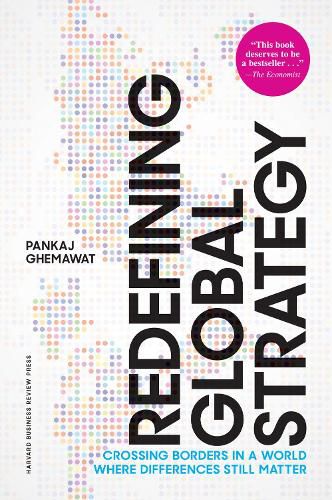Readings Newsletter
Become a Readings Member to make your shopping experience even easier.
Sign in or sign up for free!
You’re not far away from qualifying for FREE standard shipping within Australia
You’ve qualified for FREE standard shipping within Australia
The cart is loading…






Why do so many global strategies fail–despite companies’ powerful brands and other border-crossing advantages? Seduced by market size, the illusion of a borderless, flat world, and the allure of similarities, firms launch one-size-fits-all strategies. But cross-border differences are larger than we often assume, explains Pankaj Ghemawat in Redefining Global Strategy, with a New Preface . Most economic activity–including direct investment, tourism, and communication–happens locally, not internationally.
In this semi-globalized world, one-size-fits-all strategies don’t stand a chance. Companies must instead reckon with cross-border differences. Ghemawat shows you how–by providing tools for: assessing the cultural, administrative, geographic, and economic differences between countries at the industry level and deciding which ones merit attention; tracking the implications of particular border-crossing moves for your company’s ability to create value; and creating superior performance with strategies optimized for adaptation (adjusting to differences), aggregation (overcoming differences), and arbitrage (exploiting differences), and for compound objectives.
In-depth examples reveal how companies such as Cemex, Toyota, Procter & Gamble, Tata Consultancy Services, IBM, and GE Healthcare have adroitly managed crossborder differences–as well as how other well-known companies have failed at this challenge. Crucial for any business competing across borders, this book will transform the way you approach global strategy.
$9.00 standard shipping within Australia
FREE standard shipping within Australia for orders over $100.00
Express & International shipping calculated at checkout
Why do so many global strategies fail–despite companies’ powerful brands and other border-crossing advantages? Seduced by market size, the illusion of a borderless, flat world, and the allure of similarities, firms launch one-size-fits-all strategies. But cross-border differences are larger than we often assume, explains Pankaj Ghemawat in Redefining Global Strategy, with a New Preface . Most economic activity–including direct investment, tourism, and communication–happens locally, not internationally.
In this semi-globalized world, one-size-fits-all strategies don’t stand a chance. Companies must instead reckon with cross-border differences. Ghemawat shows you how–by providing tools for: assessing the cultural, administrative, geographic, and economic differences between countries at the industry level and deciding which ones merit attention; tracking the implications of particular border-crossing moves for your company’s ability to create value; and creating superior performance with strategies optimized for adaptation (adjusting to differences), aggregation (overcoming differences), and arbitrage (exploiting differences), and for compound objectives.
In-depth examples reveal how companies such as Cemex, Toyota, Procter & Gamble, Tata Consultancy Services, IBM, and GE Healthcare have adroitly managed crossborder differences–as well as how other well-known companies have failed at this challenge. Crucial for any business competing across borders, this book will transform the way you approach global strategy.